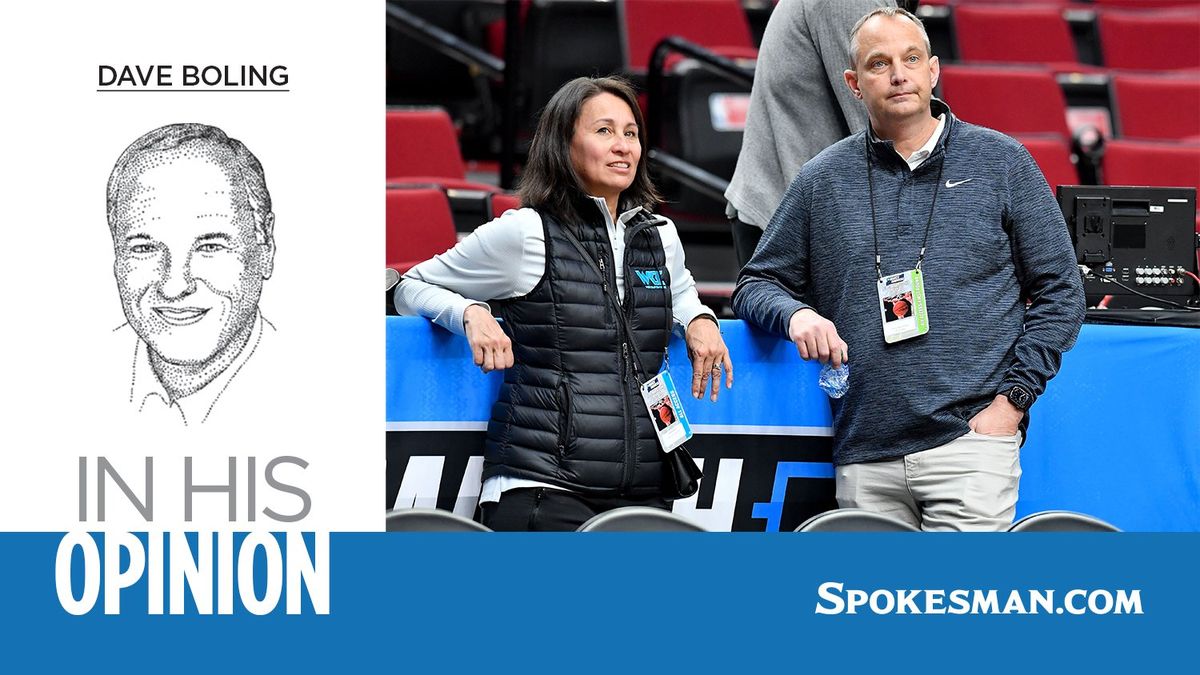Dave Boling: Gonzaga athletic director Chris Standiford remains steady in first year filled with PR snafus and a shifting collegiate landscape

Midway through a recent telephone interview, Mike Roth described his idyllic lakeside surroundings. On cue, a pair of geese flew low overhead, voicing a series of atmospheric honks. Clearly settling into a peaceful retirement, Roth sounded as if he were making a commercial for a reverse-mortgage plan.
As athletic director at Gonzaga University for 24 years, Roth has earned all the tranquility he can get. He was one of the key figures in Gonzaga’s improbable emergence from a basketball program that was rarely mentioned – and mostly mispronounced when it was – to a position of sustained national prominence. The rest of the athletic department, and the university as a whole, prospered in basketball’s wake.
Having started as one of Roth’s undergraduate work-study helpers in 1990, Chris Standiford stepped into the AD role last fall. Although Roth didn’t put it into these exact words, he has to be thinking: Man, I got out of there just in time.
Nearing the end of his first school year on the job, Standiford might be suspicious that any geese flying over him might drop unsavory surprises.
Standiford last week conceded there had been some sleepless nights along the way. But the headlines from some highly publicized diversions might have seem insignificant compared to what could arise in coming months as the NCAA redefines how colleges athletic departments may conduct business.
“These high-end, complex changes are unfolding at the most disruptive time that leaders in college sports have ever seen,” reported a recent story in Sports Business Journal. The Supreme Court’s “Alston” ruling last summer opened the door to … what? Professionalism? Free agency? Tectonic conference realignments? Competitive anarchy?
“In the current context, we don’t have many answers to what we’re going to be dealing with in the next year,” Standiford said. “We desperately need some uniformity across the country, and some common rules, but it’s also a great time – the students’ voices have never been louder, and they have some great opportunities.”
For people entrusted with fitting together complex programs, it’s unsettling that nobody can yet predict the shifting shapes of the puzzle pieces.
“I worry about the external factors that will fundamentally change how we’re able to do our jobs,” Standiford said. “In the very fluid environment that is college athletics, I want to be sure that, when there is a line drawn, we’re on the right side of it, and we’re prosperous in the same ways we (have been).”
As the NCAA Transformation Committee continues to hash out major reconstruction, the stakes for Gonzaga, and Standiford, are substantial.
According to figures in a story produced by the university website last fall, the athletic budget in 1998, when Roth took over as full-time AD, was $3 million; by 2021, it was up to $22.7 million. During that span, annual revenue grew from $250,000 to $8.6 million. And the number of full-time employees swelled from 12 to more than 100.
In essence, the 53-year-old Standiford is the CEO of a multimillion-dollar enterprise.
According to Roth, Standiford prepared for this moment with “30 years of grinding through it; he’s done every job of everybody who works in that department, so he has a tremendous understanding of what everybody is going through.”
And, Roth added, “we all know he had to deal with some specific things that happened in Gonzaga athletics this year.”
Briefly, those specific things: His head basketball coach, Mark Few, was suspended for two exhibitions and the first regular-season game after a DUI charge. And in January, iconic alum and basketball Hall of Famer John Stockton had his season tickets suspended for failing to comply with the university’s mask mandate at games.
Stockton and Few in dubious headlines? What’s next, Bing Crosby stumbling on the lyrics of “White Christmas?” If Gonzaga ever decided to fashion a couple of bronze wingmen for Crosby’s statue on campus, I’d suggest they start with figures of Stockton and Few. Not only because of their massive successes, but how they have been exemplars of Gonzaga, and the “Gonzaga Way” – resolute underdogs, conducting themselves with humility and propriety, yet driven to excellence.
So, sure, these were unprecedented times for the head of the athletic department. Which, according to Roth, was the reason it was perfect that Standiford was in charge.
“Chris was there with me for every major decision made in the department in my 24 years,” Roth said. “He had built long-term relationships, and trust, with all the people involved. I think if (the new AD) had been (somebody) from outside the Gonzaga sphere … I’m not sure it would have gone as well.”
Look back to GU’s first appearance on the national scene: Roth, Few and Standiford were all in place. Roth had the second-longest tenure at the same school in Division I when he retired. And, now, only four Division I basketball coaches have been at their schools longer than Few.
Compare the GU program that went to the Elite Eight in 1999 with the 15th-seeded St. Peter’s team that captured the nation’s attention at the 2022 tournament. Since their Elite Eight loss, the St. Peter’s head coach left for Seton Hall and six players entered the transfer portal.
It’s a time with different rules, of course, but Gonzaga also is a place that somehow lures people into staying, as if the gravity is especially powerful.
These people are durable and stubborn and unlikely to run from challenges; they’re not eager to find new ones elsewhere, nor as easily swayed by fiscal incentives – qualities ever more important now as college sports continue to evolve.